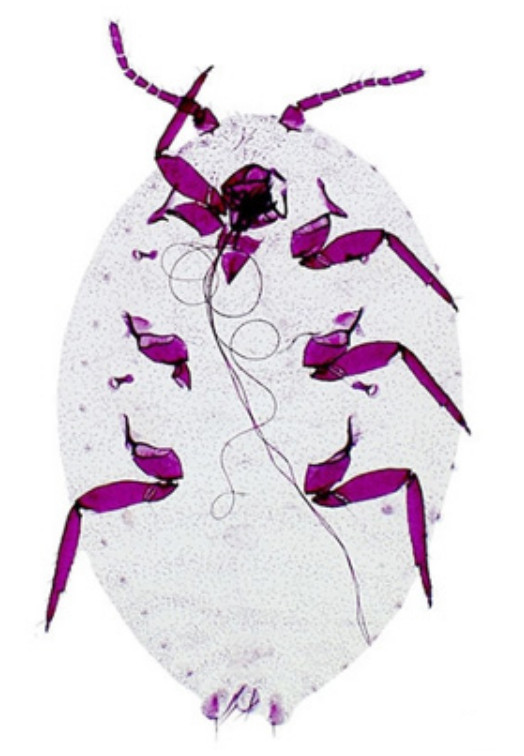Valid Names Results
Pseudococcus landoi (Balachowsky, 1959) (Pseudococcidae: Pseudococcus)Nomenclatural History
- Paracoccus landoi Balachowsky 1959: 345. Type data: COLOMBIA: Cordoba, Alto Sinu, 4 km Tukuru, on undetermined plant. Holotype, female, Type depository: Paris: Museum National d'Histoire naturelle, France; accepted valid name Illustr.
- Pseudococcus landoi (Balachowsky, 1959); Williams & Granara de Willink 1992: 449. change of combination
Common Names
- Lando mealybug GimpelMi1996
- Cochinilla harinosa de Lando WatsonKoLa2022
Ecological Associates
Hosts:
Families: 17 | Genera: 25
- Anacardiaceae
- Schinus terebinthifolia | GimpelMi1996
- Araceae
- Anthurium | GimpelMi1996
- Dieffenbachia | GimpelMi1996
- Philodendron | BenDov1994 GimpelMi1996 WilliaGr1992
- Asparagaceae
- Yucca gigantea | GimpelMi1996 | (= Yucca elephantipes)
- Chrysobalanaceae
- Licania tomentosa | BenDov1994 WilliaGr1992
- Euphorbiaceae
- Codiaeum | GimpelMi1996
- Mabea | BenDov1994 WilliaGr1992
- Manihot aesculifolia | GranarGo2018
- Manihot esculenta | FoldiKo2006
- Fabaceae
- Phaseolus lunatus | GimpelMi1996
- Heliconiaceae
- Heliconia | GimpelMi1996
- Lauraceae
- Persea americana | KondoMu2016
- Malvaceae
- Abelmoschus esculentus | GimpelMi1996
- Theobroma cacao | BenDov1994 GimpelMi1996 WilliaGr1992
- Moraceae
- Artocarpus altilis | GimpelMi1996
- Ficus benjamina | BenDov1994 WilliaGr1992
- Musaceae
- Musa | GimpelMi1996 WilliaGr1992
- Orchidaceae
- Orchidaceae | GimpelMi1996
- Passifloraceae
- Passiflora | Balach1959 BenDov1994
- Piperaceae
- Piper auritum | BenDov1994 WilliaGr1992
- Rubiaceae
- Coffea arabica | GimpelMi1996
- Coffea canephora | BenDov1994 WilliaGr1992
- Simira maxonii | BenDov1994 WilliaGr1992 | (= Sickingia maxonii)
- Vochysiaceae
- Vochysia | BenDov1994 WilliaGr1992
- Zingiberaceae
- Alpinia purpurata | GimpelMi1996
- Zingiber | GimpelMi1996
Geographic Distribution
Countries: 14
- Antigua and Barbuda
- Barbuda | GimpelMi1996
- Barbados | GranarGo2018
- Brazil | GimpelMi1996 WilliaGr1992
- Amazonas | FoldiKo2006
- Colombia | Balach1959 GimpelMi1996 WilliaGr1992 | KondoMu2016
- Costa Rica | GimpelMi1996 WilliaGr1992
- Cuba | GimpelMi1996
- Ecuador | GimpelMi1996
- Guatemala | GimpelMi1996 WilliaGr1992
- Guyana (=British Guiana) | GimpelMi1996
- Honduras | GimpelMi1996 WilliaGr1992
- Mexico | GimpelMi1996
- Nicaragua | GimpelMi1996
- Panama | GimpelMi1996 WilliaGr1992
- Trinidad and Tobago
- Trinidad | WilliaGr1992
Keys
- CaballKo2024: pp.7 ( Adult (F) ) [Species associated with coffee roots in Colombia]
- Suh2019a: pp.2-6 ( Adult (F) ) [mealybugs intercepted in S. Korea]
- GranarGo2018: pp.10-14 ( Adult (F) ) [Central & South American Pseudococcus]
- VonEllWa2016: pp.77 ( Adult (F) ) [Pseudococcus species present in the New World]
- ParsaKoWi2012: pp.10-Aug ( Adult (F) ) [Key to mealybugs (Hemiptera: Pseudococcidae) recorded on Manihot spp. (Euphorbiaceae) in the World]
- GimpelMi1996: pp.18 ( Adult (F) ) [World]
- GimpelMi1996: pp.137 ( Immature (F) ) [World]
- WilliaGr1992: pp.427 ( Adult (F) ) [Central and South America]
Remarks
- Systematics: Pseudococcus landoi is similar to P. elisae. Pseudococcus elisae has: 1 oral rim posterior of each frontal cerarius; dorsal oral-rim tubular ducts; 14(5-25) oral collars in cluster mesad of cerarius 12; longest ventral body setae 76(62-91)!l long; labium 191(173-203)µ long; translucent pores on hind femur. Pseudococcus landoi differs by having: No oral rims posterior of frontal cerarii; no dorsal oral-rim tubular ducts; 43(28-51) oral collars in cluster mesad of cerarius 12; longest ventral body seta 55(24-73)µ long; labium 219(185-293)µ long; no translucent pores on hind femur. (Gimpel & Miller, 1996)
- Structure: Translucent pores restricted to hind tibiae; 8(6-11) discoidal pores associated with eye in sclerotized rim; oral-rim tubular ducts usually restricted to venter, absent posterior of frontal cerarius; 43(28-51) oral-collar tubular ducts associated with cerarius 12; cisanal setae 91(73-147)µ long; interantennal setae 140(122-17.6)µ long. (Gimpel & Miller, 1996)
- General Remarks: Good description and illustration of the adult female given by Balacowsky (1959) and by Gimpel & Miller (1996). Good description and illustration of the third instar female given by Gimpel & Miller (1996).
Illustrations
Citations
- Balach1959: description, distribution, host, illustration, taxonomy, 345-347
- BenDov1994: catalog, 396
- CaballKo2024: key, morphology, 7
- CaballPaKa2021: distribution, 10
- CaballRaGi2018: distribution, host, 122
- DiazNiPiMe2023: biology, diagnosis, economic control, host, illustration, life cycle, male, morphology, 8, 27
- FoldiKo2006: distribution, host, 309
- GimpelMi1996: description, distribution, host, illustration, taxonomy, 72-75, 145-149
- GranarGo2018: diagnosis, distribution, host, illustration, key, taxonomy, 4-14, 32
- Kondo2001: distribution, host, taxonomy, 38
- KondoMu2016: distribution, host, illustration, 11-12
- KondoWa2022a: distribution, host, list, 25
- PalmaJBlGu2019: host,
- ParsaKoWi2012: taxonomy, 9
- SchneiLa2020: ant association, 288
- Suh2019a: key, 2
- VonEllWa2016: distribution, host, key, morphology, structure, 74-82
- WatsonKoLa2022: biology, control, destructor, diagnosis, distribution, host, illustration, 198-199
- WilliaGr1992: distribution, host, taxonomy, 449-450
- WilliaMa2012: distribution, host, 90




